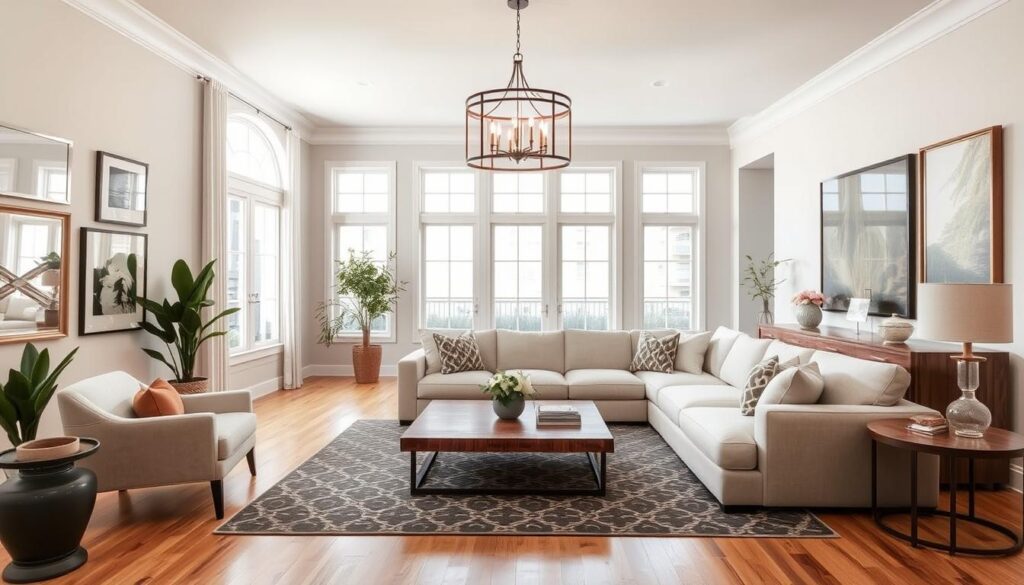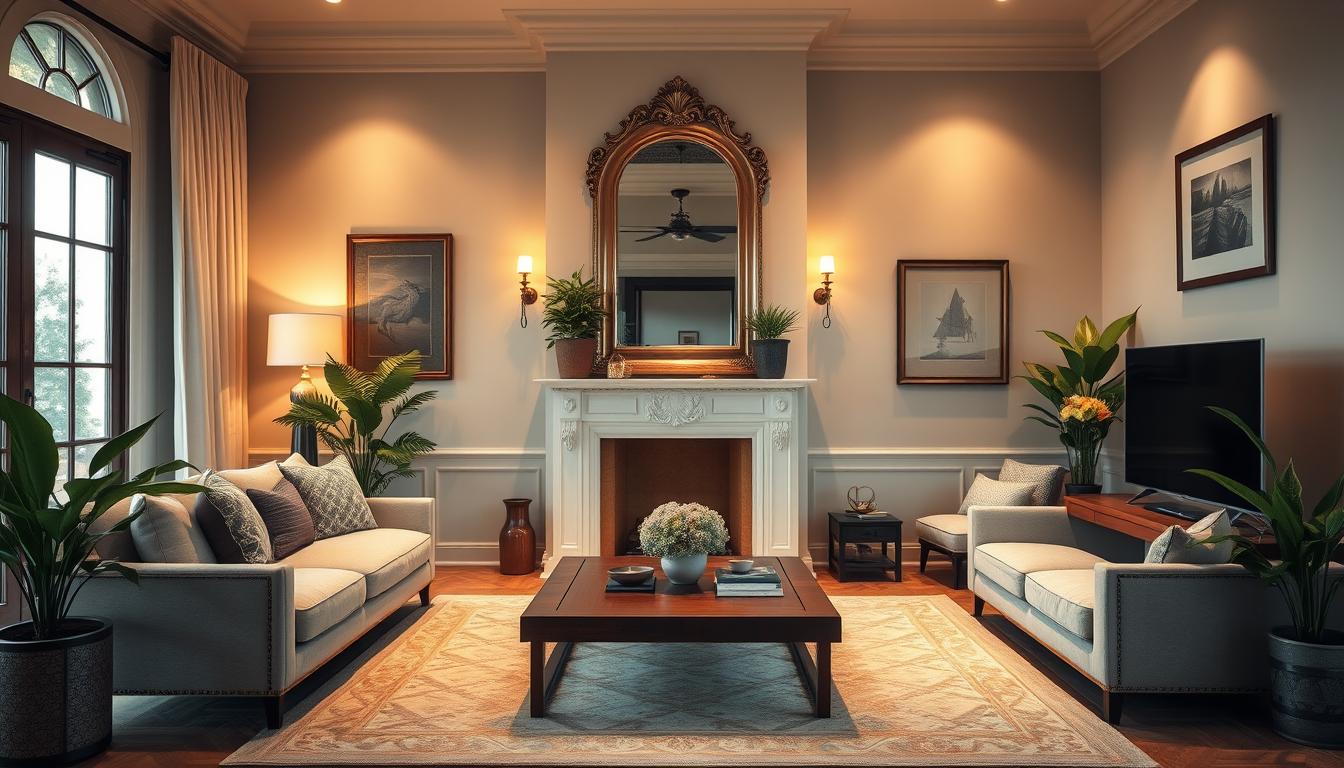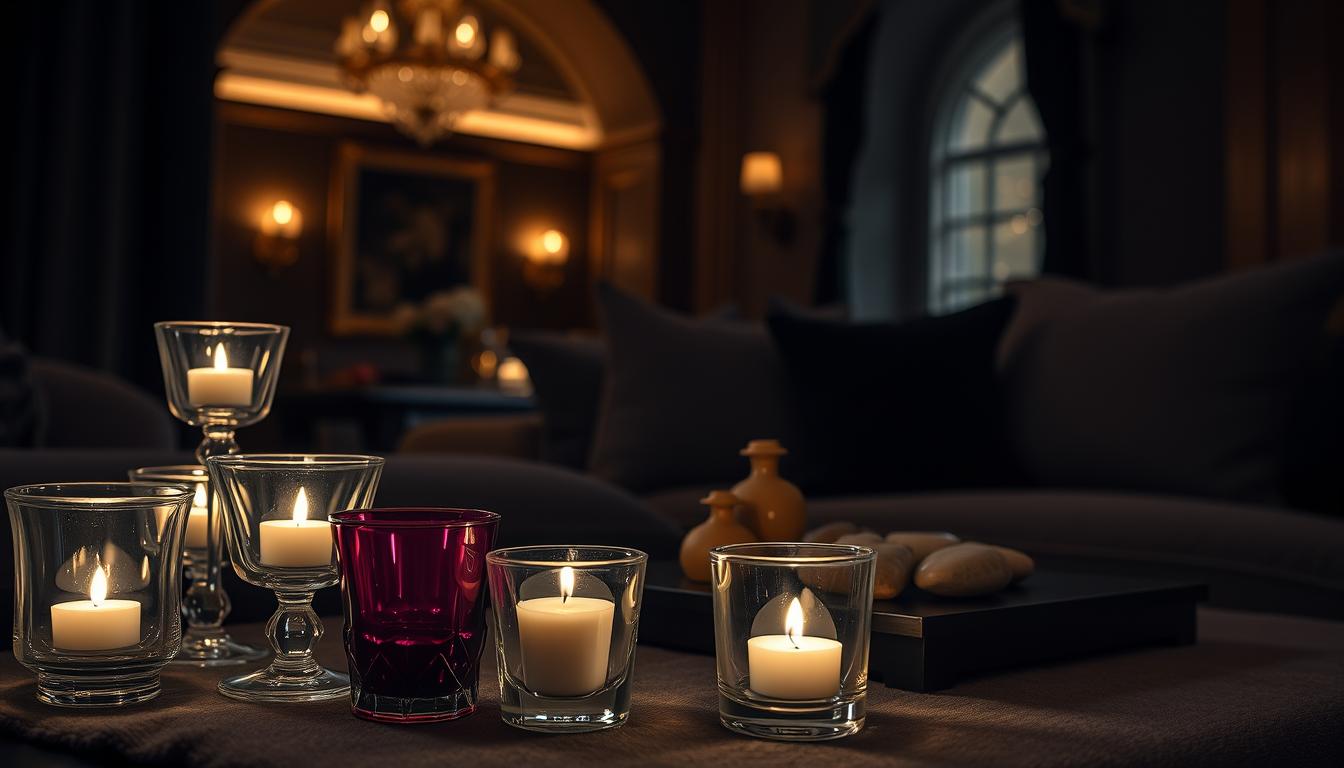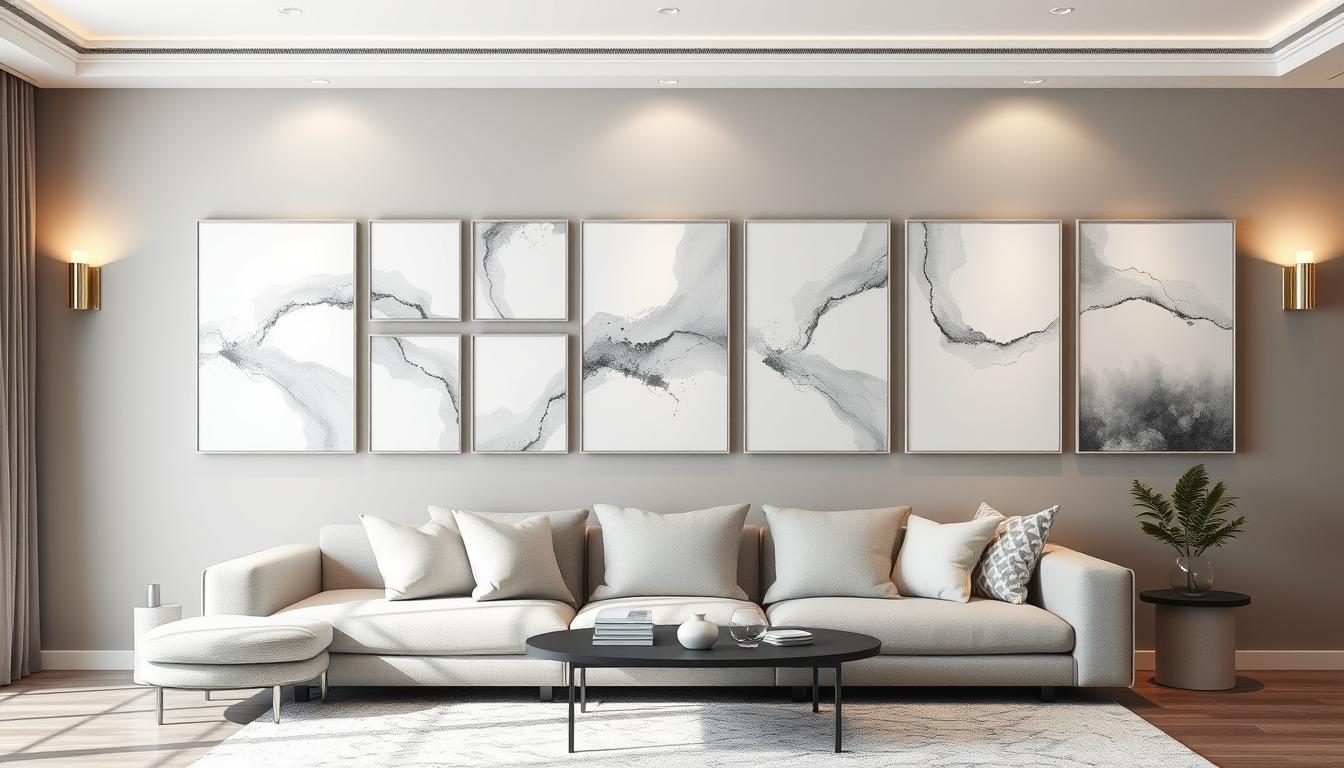Did you know that how we design our homes can really affect our mood and how well we work? With various home interior design styles out there, it’s easier than ever to create a space that shows who you are and meets your needs.
We’ll look at the most popular home interior design styles to help you find the perfect look for your home. Whether you want to redo your whole home or just one room, knowing these styles is key. For more on interior design, check out our article on exploring different home interior design styles.
Key Takeaways
- Understanding the characteristics of various home interior design styles.
- Identifying the benefits of different design styles for your home.
- Exploring examples of popular interior design styles.
- Learning how to choose the right style for your space.
- Discovering how to mix elements from multiple styles.
Understanding Home Interior Design Styles
The world of interior design is vast and varied. It offers many styles to fit every taste and preference. As we explore home interior design, starting with the basics is key.
What is Interior Design?
Interior design is the art and science of making buildings’ interiors better. It aims to create a healthier and more beautiful space for those who use it. It involves understanding space, color, and choosing furniture and decor that shows the occupant’s lifestyle and preferences.
Good interior design is more than just decoration. It’s about making a space that is both functional and beautiful. It should improve the life of those who live there. Whether you prefer modern interior design or traditional interior design, the most important thing is to choose a style that feels right to you.
Importance of Style in Interior Design
The style in interior design is the aesthetic approach used to achieve a desired ambiance and functionality. Different styles can change a room’s look and feel. It’s crucial to pick a style that fits your preferences and lifestyle.
Modern interior design focuses on function, simplicity, and a monochromatic color scheme with bold accents. In contrast, traditional interior design uses classic elements, rich colors, and ornate details. It creates a cozy and welcoming atmosphere.
Understanding the role of style in interior design helps homeowners make better decorating choices. By picking a style that reflects their personality and meets their needs, they can create a home that is both beautiful and practical.
Classic Design Styles
Classic design styles have been around for centuries. They bring timeless elegance to any space. These styles focus on detail, rich materials, and classic furniture that adds history and sophistication.
Traditional Interior Design
Traditional interior design uses rich colors and ornate details. It’s warm and comfortable, often featuring wood paneling, intricate patterns, and luxurious fabrics.
Key elements of traditional design include:
- Rich color palettes
- Ornate details and patterns
- Classic furniture pieces
- Luxurious fabrics and textiles
Rustic Design Elements
Rustic design elements add a cozy, natural feel. They often use wood and stone. This style creates a warm, inviting atmosphere, perfect for homes that feel like the outdoors.
| Material | Characteristics | Uses |
|---|---|---|
| Wood | Natural, warm, textured | Furniture, flooring, walls |
| Stone | Durable, natural, varied | Fireplaces, flooring, countertops |
| Brick | Rugged, textured, historic | Walls, fireplaces, exterior |
Colonial Influences
Colonial influences add a historical touch to design. They reflect colonial America’s architectural and decorative styles. This style often includes classic furniture, traditional patterns, and a neutral color palette with rich color accents.
To add colonial influences to your home, consider:
- Using traditional furniture with a classic silhouette
- Incorporating historical patterns and textiles
- Adding decorative elements like moldings and cornices
By mixing these classic styles, homeowners can create a unique, inviting space. It reflects their personal taste and style.
Modern Design Styles
Modern design styles have changed how we see interior spaces. They focus on function, simplicity, and clean lines. This offers a new look compared to traditional decorating.
Characteristics of Modern Design
Modern interior design stands out with neutral colors, new materials, and open spaces. Clean lines and minimal ornamentation are key. They bring calm and serenity to homes.
Natural light is also key in modern design. Big windows and skylights let in light. This reduces the need for artificial lights and blends indoors with outdoors.
Minimalism in Interior Design
Minimalism goes further by removing what’s not needed. It makes spaces clean and functional. This design is not just about looks; it’s about making spaces better to live in.
To achieve a minimalist look, choose furniture and decor that are simple and useful. By reducing what we own, we make our homes clearer and more meaningful.
- Use a limited color palette to maintain visual cohesion.
- Select furniture with clean lines and minimal ornamentation.
- Incorporate natural materials and textures to add depth to your space.
Contemporary Design Trends
Today’s design trends are changing how we see our homes. They focus on being green and flexible. It’s not just about looks; it’s about making spaces that work well and can change.
Overview of Contemporary Style
Contemporary style is all about being flexible. It uses many materials, colors, and textures. It’s a style that loves to try new things and stay fresh.
Key characteristics include caring for the planet, using green materials, and saving energy. It also loves open spaces, simple designs, and being useful.
Key Features of Contemporary Design
Some key features of contemporary design are:
- Using sustainable and eco-friendly materials
- Focus on saving energy and being kind to the environment
- Open floor plans for a big feel
- Simple designs with clean lines
- Adding tech to make life easier
Design experts say, “Contemporary design looks to the future while caring for our planet.” It makes homes that are modern, chic, and practical.
“The best contemporary designs are those that balance form and function, creating spaces that are both beautiful and livable.”
Blending with Modern Elements
Mixing contemporary design with modern touches makes a space unique and eye-catching. Modern design is all about bold statements, new materials, and the latest tech.
To mix these styles well, combine contemporary’s simplicity with modern’s boldness. This mix can make a space that’s both trendy and stylish.
For instance, a modern, bold-colored chair next to a simple contemporary sofa can make a room pop.
Industrial Interior Design
Industrial interior design is a big hit in modern homes. It takes inspiration from old factories and industrial areas. This style is known for its raw, unfinished look, giving homes a unique charm.
Origins of Industrial Style
The industrial style started when old industrial buildings were turned into homes. People kept the original features like exposed brick walls and metal beams. This created a special look.
Key elements of industrial style include:
- Exposed ductwork and pipes
- Metal accents and beams
- Reclaimed wood and brick
Common Materials Used
Industrial design uses materials that are raw and unfinished. Some common ones are:
| Material | Description | Use in Design |
|---|---|---|
| Concrete | A durable, versatile material | Flooring, walls |
| Steel | A strong, industrial metal | Beams, accents |
| Brick | A classic, rustic material | Walls, feature walls |
Color Schemes and Finishes
The colors in industrial design are mostly neutral. They focus on earthy tones and metallics. You’ll see a lot of:
- Neutrals: gray, beige, taupe
- Earth tones: brown, green
- Metallic: silver, copper, gold
Finishes are often left raw. This lets the natural texture of the materials shine.
Bohemian and Eclectic Styles
Bohemian and eclectic interior design celebrate being different and creative. They let homeowners make a space that shows off their unique style and taste.
Embracing Personalization
Personalization is key in bohemian and eclectic design. Homeowners are free to mix different things to make a space that feels real and special. This means combining old and new items, different textures, and bright colors.
To get a bohemian or eclectic vibe, add personal touches like artwork, collectibles, or family treasures to your decor. Layering different textures and patterns also brings depth and interest to your space.
“The essence of bohemian style lies in its ability to blend the old with the new, creating a unique and captivating aesthetic.”
Key Characteristics of Bohemian Design
Bohemian design is all about mixing things up. It’s known for:
- Vibrant colors and patterns
- Rich textures like velvet, linen, and wood
- Vintage and global elements
- Layered lighting and eclectic decor
To show how diverse bohemian design can be, here’s a table with some key elements and what they’re like:
| Element | Characteristics |
|---|---|
| Vintage Furniture | Unique pieces, distressed finishes |
| Global Textiles | Colorful patterns, rich textures |
| Layered Lighting | Mix of table lamps, floor lamps, and string lights |
By using these elements, homeowners can make a bohemian or eclectic space that stands out.
Mid-Century Modern Influence
The mid-century modern design movement has greatly influenced today’s interior design. It focuses on clean lines and organic shapes. This style is now popular again because of its simple design and beauty.
Hallmarks of Mid-Century Style
Mid-century modern style stands out with its use of new materials and focus on lines. It also uses organic shapes and minimal ornamentation. This creates a feeling of openness and simplicity.
Some key features of mid-century modern design include:
- Clean lines and minimal decor
- An emphasis on functionality
- Incorporation of natural materials
- Large windows to bring in natural light
Furniture and Decor Tips
To add mid-century modern style to your home, follow these tips:
| Furniture Piece | Characteristics | Tips for Incorporation |
|---|---|---|
| Sofas and Chairs | Clean lines, tufted upholstery | Choose pieces with a low profile and simple legs. |
| Coffee Tables | Organic shapes, wooden or glass tops | Opt for a table with a simple base and a natural finish. |
| Lighting | Sputnik chandeliers, globe lights | Select fixtures that add a touch of retro charm. |
As
“The modern home is not a container for living, it is a part of the living itself.” – Charles Eames
, a pioneer of mid-century modern design, shows the importance of combining form and function.
By embracing mid-century modern, you can make a home that’s both stylish and practical. It focuses on simplicity and clean lines.
Coastal and Nautical Designs
Coastal design brings the freshness and freedom of the sea into your home. It’s perfect for those who love the ocean’s serenity.
Creating a Beach-Inspired Space
To make a beach-inspired space, use elements that show the coast’s beauty. Choose a light color palette with blues, greens, and sandy neutrals. Add natural textures like wicker, jute, and driftwood for depth and warmth.
Nautical Elements: Anchors, ropes, and shells are great for a coastal look. Use them sparingly to keep the space balanced.
Color Palettes and Textures
The right colors and textures are key for a coastal vibe. Soft blues and whites, along with warm wood tones, create a calming feel. Add textures with throw blankets, rugs, and pillows in natural fibers.
| Element | Description | Examples |
|---|---|---|
| Color Palette | Light, airy shades | Soft blues, whites, sandy neutrals |
| Textures | Natural fibers and materials | Wicker, jute, driftwood |
| Nautical Elements | Decorative items inspired by the sea | Anchors, ropes, shells |
By mixing these elements, you can make a coastal interior design that’s both relaxing and welcoming. Whether you’re by the beach or dreaming of it, these tips can bring the coast into your home.
Farmhouse Aesthetics
Farmhouse aesthetics bring a warm, welcoming feel to any home. They use natural materials and classic colors. This style is all about comfort and simplicity.

Distinctive Features of Farmhouse Style
Farmhouse style focuses on simplicity and comfort. Key elements include reclaimed wood, vintage fixtures, and traditional furnishings. These elements create a cozy, rustic feel.
The color palette is often neutral tones and soft pastels. This mix adds calm and serenity. Textiles like linen and cotton add texture and comfort.
How to Incorporate Rustic Decor
To add rustic decor, start with natural materials and vintage pieces. Use reclaimed wood for furniture or flooring. Add vintage fixtures like old metal lamps or antique hardware.
Rustic decor can be mixed with modern elements for a unique look. For example, pair a vintage wooden table with modern chairs. This adds interest to your dining area.
- Use natural materials like wood and stone
- Incorporate vintage fixtures and antique pieces
- Choose a neutral color palette with soft pastels
Art Deco Revival
Art Deco, born in the 1920s, is back in style. It brings luxury and glamour to today’s homes. This style is known for its geometric shapes, metallics, and bold colors.
The Elegance of Art Deco
Art Deco is all about elegance and glamour. It uses luxurious materials and ornate decoration. This creates a sense of luxury in any room.
“Art Deco is not just a style; it’s an attitude towards life that celebrates luxury, glamour, and modernity.”
To add Art Deco to your home, look for bold lighting and decorative items. These pieces can make any room feel elegant and sophisticated.
Key Elements to Include
When designing an Art Deco space, focus on these key elements:
- Geometric patterns and shapes
- Metallic materials like chrome and silver
- Bold, contrasting colors
- Luxurious materials like velvet and marble
- Ornate decoration, including inlays and etchings
Adding the right furniture and decor can enhance your Art Deco space. Look for vintage or vintage-inspired pieces to add authenticity.
| Element | Description | Example |
|---|---|---|
| Geometric Patterns | Use of chevron, zig-zag, and other geometric motifs | Chevron-patterned wallpaper |
| Metallic Materials | Incorporation of metallic accents for glamour | Chrome lighting fixtures |
| Bold Colors | Use of vibrant, contrasting colors | Bold red and black color scheme |
By using these elements, you can create a space full of glamour and sophistication. Whether it’s a single room or a whole home, Art Deco revival is perfect for luxury and elegance.
Scandinavian Design Principles
Scandinavian design combines form and function to make spaces warm and inviting. It comes from Nordic countries and is loved worldwide for its simplicity, comfort, and practicality.
Importance of Functionality
Functionality is key in Scandinavian design. It’s not just about looks; it’s about making spaces useful and cozy. Design expert, Kari Traa, said, “The goal is to create a sense of comfort and warmth without clutter.”
“Good design is about creating a balance between form and function.” –
This idea is seen in multi-functional furniture. Pieces like storage ottomans and extendable dining tables are perfect examples.
Incorporating Natural Elements
Scandinavian design often uses natural elements for warmth and texture. Wood, like oak and pine, is a favorite for flooring, furniture, and walls.
- Use natural materials like wood and wool
- Incorporate plants for a touch of greenery
- Opt for light, airy color palettes
By using these elements, you can make a cozy and inviting space. It captures the essence of Scandinavian design.
In conclusion, Scandinavian design is a timeless approach to interior design. It focuses on simplicity, functionality, and comfort. By adding these elements, you can make a beautiful and welcoming space.
Transitional Style
Transitional style is becoming more popular. It blends traditional elegance with modern simplicity. This mix creates a welcoming and unique space.
Blending Classic and Contemporary Elements
To get a transitional look, mix traditional and modern styles carefully. Start with a neutral color palette. Then, combine a classic sofa with a sleek coffee table.
Think about scale and proportion when mixing styles. For example, pair a big traditional sofa with a minimalist armchair.
Achieving Balance in Decor
Balance is key in transitional design. Spread visual weight evenly in the room. Use traditional pieces with modern ones to achieve this.
For example, a wooden dresser can be balanced by a minimalist mirror. Mixing textures like wood, metal, and fabric adds depth and interest.

| Design Element | Traditional Style | Modern Style | Transitional Style |
|---|---|---|---|
| Furniture | Ornate, curved lines | Simple, clean lines | Mix of classic and modern pieces |
| Color Palette | Rich, bold colors | Neutral, monochromatic | Neutral with pops of color |
| Textures | Luxurious fabrics, wood | Metal, glass, minimalist fabrics | Mix of luxurious and minimalist textures |
By mixing the best of traditional and modern styles, you can create a transitional space. This style is elegant and inviting. It’s also flexible, allowing for personal touches and unique decor.
Choosing the Right Style for Your Home
Finding the perfect interior design style for your home can be tough. There are so many styles out there. It’s key to think about what you like and how you live to pick a style that’s both beautiful and practical.
Personal Taste Assessment
First, think about what you like and dislike in different styles. Maybe you love the classic look of traditional design or the clean lines of modern minimalism. Or perhaps you’re into mixing styles to make a space that’s all your own.
Blending Styles
Mixing styles can lead to a unique and beautiful space that shows off your personality. Begin by finding common elements like colors or textures that you like. Then, add special pieces from each style to make a space that feels just right for you.



